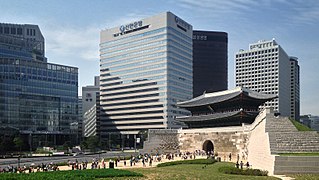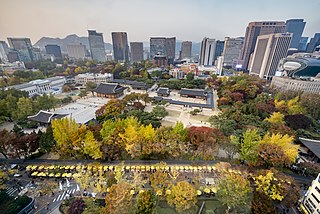Contents
There are over 100 museums in Seoul.
There are over 100 museums in Seoul.
| Museum | Korean name | Location | Note | Link |
|---|---|---|---|---|
| National Folk Museum of Korea | 국립민속박물관 | 35 Samcheongdong-gil, Jongno District | Situated near Gyeongbokgung | |
| National Museum of Korea | 국립중앙박물관 | Yongsan-dong, Yongsan District | ||
| National Museum of Korean Contemporary History | 대한민국역사박불관 | 198 Saejongdae-ro, Jongno District, Seoul | Situated near Gyeongbokgung | |
| National Palace Museum of Korea | 국립고궁박물관 | Sajikno 34 (Sejongno), Jongno District | Situated near Gyeongbokgung | |
| National Museum of Modern and Contemporary Art | 국립현대미술관 | 30, Samcheong-ro, Jongno District | Situated near Gyeongbokgung | |
| Korean Film Museum | 한국영화박물관 | 400, Worldcupbuk-ro, Mapo District |
| Museum | Korean name | Location | Note | Link |
|---|---|---|---|---|
| Heojun Museum | 허준박물관 | Gayang 2-dong, Gangseo-gu | ||
| Global Village Folk Museum | 지구촌 민속교육박물관 | F2 ~3 Seoul Education Research & Information Institute, 112 Sowol-ro (100-177 1ga Hoehyeon-dong), Jung District | Closed permanently as of 2016 | |
| SeMa GyeongHuiGung | 서울시립미술관 경희궁분관 | 2-1, Sinmunno 2-ga, Jongno District | ||
| SeMa NamSeoul | 서울시립미술관 남서울분관 | 1059-13 Namhyeon-dong, Gwanak-gu | ||
| Seodaemun Museum of Natural History | 서대문 자연사박물관 | San 5-58 Yeonhui-3 dong, Seodaemun District | ||
| Seoul Education Museum | 서울교육사료관 | 19 Bukchon-gil (2 Hwa-dong), Jongno District | ||
| Seoul Museum of Art (SeMa) | 서울시립미술관 | Misulgwan-gil 30 (Seosomun-dong 37), Jung District | ||
| Seoul Museum of History | 서울역사박물관 | 2-1 Sinmunno 1-ga, Jongno District | ||
| Seoul Urban Life Museum | 서울생활사박물관 | Nowon District | ||
| War Memorial of Korea | 전쟁기념관 | 1ga-8 Yongsan-dong, Yongsan District | ||
| Seoul Baekje Museum | 한성백제박물관 | 71, Wiryeseong-daero, Songpa-gu71 |

Seoul National University is a public research university located in Seoul, South Korea. It is one of the SKY universities and a part of the Flagship Korean National Universities.

Gyeonggi-do is the most populous province in South Korea.

Iksan is a city and major railway junction in North Jeolla Province, South Korea.

The N Seoul Tower, officially the YTN Seoul Tower and commonly known as Namsan Tower or Seoul Tower, is a communication and observation tower located on Namsan Mountain in central Seoul, South Korea. The 236-meter (774 ft)-tall tower marks the second highest point in Seoul and is considered a local landmark.

Goyang is a city in Gyeonggi Province in the north of South Korea. It is part of the Seoul Capital Area, making Goyang one of Seoul's satellite cities. It is one of the largest cities in the Seoul Capital Area, with a population of just over 1 million. Ilsan, a planned city, is located in the Ilsandong-gu and Ilsanseo-gu districts of Goyang. It also includes Deogyang-gu which is closer to Seoul.

Gwacheon is a city in Gyeonggi Province, South Korea. It lies close to Seoul in the heart of the Seoul National Capital Area, and also lies just east of Anyang. Seoul Subway Line 4 passes through the city.

Seongnam is the fourth largest city in South Korea's Gyeonggi Province after Suwon and the 10th largest city in the country. Its population is approximately one million. Seongnam, the first planned city in Korea's history, was conceived during the era of President Park Chung-Hee for the purpose of industrializing the nation by concentrating electronic, textile, and petrochemical facilities there during the 1970s and 1980s. The city featured a network of roads, to Seoul and other major cities, from the early 1970s on. Today, Seongnam has merged with the metropolitan network of Seoul. Bundang, one of the districts in Seongnam, was developed in the 1990s.

Tourism in South Korea and its industry caters to both foreign and domestic tourists. In 2019, 17.5 million foreign tourists visited South Korea, making it the 20th most visited country in the world. Most non-Korean tourists come from East Asia and North America, such as Taiwan and the United States. The popularity of Korean popular culture, often known as the "Korean Wave", in countries around the world has significantly increased tourist arrivals.

National Folk Museum of Korea (Korean: 국립민속박물관) is a national museum located on the grounds of Gyeongbokgung Palace in Jongno-gu, Seoul, South Korea. It uses replicas of historical objects to illustrate the history of traditional life of the Korean people.

Jung District is one of the 25 districts of Seoul, South Korea.

Museum Kimchikan, formerly Kimchi Field Museum, is a food museum in Insa-dong, Jongno District, Seoul, South Korea. It originally opened in 1986 as the first such museum in Korea, and has since moved locations twice. It focuses on kimchi: one of the staples of Korean cuisine.
The Chojun Textile and Quilt Art Museum (Korean: 초전섬유퀼트박물관) is a textile museum located in Myeong-dong, Seoul, South Korea.
The Han Sang Soo Embroidery Museum is an art museum specializing in Korean embroidery located in Gahoe-dong, Jongno-gu, central of Seoul, South Korea. It was established by Han Sang Soo, who holds a title as a jasujang, a profession recognized as an Important Intangible Cultural Property by the Cultural Heritage Administration of South Korea.
Plateau was an art gallery in South Korea on Taepyeongno street in Jongno-gu, a central district of Seoul. The gallery contained sculptures of Auguste Rodin (1840–1917). It opened on the first floor of Samsung Life Insurance building on May 14, 1999, as 'Rodin Gallery'. In May 2011 the gallery was renamed 'Plateau' in order to better express its 'commitment to embracing the Korean and international contemporary Art Scene'. It closed in August 2016.

The Seoul Museum of Art (Korean: 서울시립미술관) is an art museum operated by Seoul City Council and located in central of Seoul, South Korea.

Seoul, officially Seoul Special City, is the capital and largest city of South Korea. The broader Seoul Capital Area, encompassing Gyeonggi province and Incheon metropolitan city, emerged as the world's fourth largest metropolitan economy in 2014, trailing only Tokyo, New York City, and Los Angeles, hosting more than half of South Korea's population. Although Seoul's population peaked at slightly over 10 million, it has gradually decreased since 2014, standing at approximately 9.97 million residents as of 2020. Seoul is the seat of the South Korean government.
The following is a timeline of the history of the city of Seoul, South Korea.

The National Museum of Contemporary Art, Korea (MMCA) is a contemporary art museum with four branches in Gwacheon, Deoksugung, Seoul and Cheongju. The museum was first established in 1969 as the only national art museum in the country accommodating modern and contemporary art of Korea and international art of different time periods.